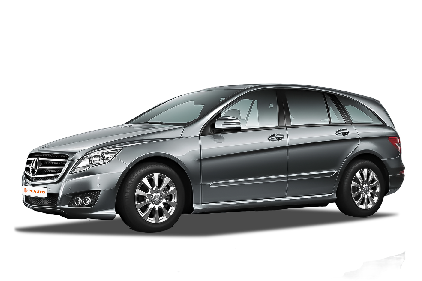Q
What are the body dimensions of Mercedes R-Class?
The dimensions of the Mercedes R-Class vary slightly depending on the specific model. Taking a 2017 model as an example, its exterior measures 5,159mm in length, 1,922mm in width, and 1,663mm in height, with a wheelbase of 3,215mm. Such dimensions create a spacious interior where both front and rear passengers enjoy ample headroom and legroom, easily accommodating family trips or business transportation needs.
The spacious wheelbase also helps enhance driving stability. The vehicle offers sufficient trunk capacity for luggage storage. As a luxury MPV, the Mercedes R-Class successfully balances comfortable riding experiences with practical dimensions, providing convenience for both daily use and travel.
Special Disclaimer: This content is published by users and does not represent the views or position of PCauto.
Related Q&A
Q
What is the idle mode of the Mercedes R-Class?
The idle mode of the Mercedes R-Class typically refers to the state where the engine maintains a low rotational speed (approximately 600-800 rpm) while stationary, allowing electrical systems like air conditioning and audio to continue operating. Equipped with either M272 or M273 engines featuring electronic throttle control, the vehicle automatically adjusts idle speed to ensure smooth operation and minimize vibrations.
For variants with the ECO Start/Stop system (available in certain international models), the engine automatically shuts off under specific conditions (such as when braking or stationary) to conserve fuel, restarting upon brake release. While idling with air conditioning is common in Malaysia's hot climate, prolonged idling may increase carbon buildup risk - occasional brief operation at 2000 rpm is recommended to help clear deposits.
Mercedes' sophisticated idle control technology generally prevents noticeable vibrations or unstable rpm, though abnormal symptoms (excessive rpm fluctuation) may indicate throttle body contamination or sensor malfunction requiring dealership inspection. As a premium family vehicle, the R-Class performs well in idle refinement with superior noise suppression and smoothness compared to conventional models, complemented by smooth power delivery when stationary thanks to its 7G-Tronic transmission.
Q
What's the size of the trunk of Mercedes R-Class?
The Mercedes R-Class offers a standard trunk capacity of 470 liters with a relatively flat floor, and split-folding rear seats to expand cargo space. Some differences may exist across different models or configurations.
Typically, family sedans provide around 450 liters of trunk space, with conventional sedans ranging between 350 to 500 liters. SUV models generally offer 300 to 600 liters of cargo capacity, expandable to 1,300-1,800 liters with rear seats folded down.
The R-Class performs well in the trunk capacity, comfortably meeting daily cargo needs while offering flexible space adjustment through its foldable rear seats for larger item transportation.
Q
What is the length of the Mercedes R-Class?
The Mercedes R-Class measures 5,159 mm in length, providing ample interior space, offering spacious legroom for passengers and abundant luggage capacity - making it particularly suitable for family trips or business use.
With a width of nearly 2 meters, the vehicle ensures driving stability while enhancing shoulder comfort for occupants. The remarkable 3,215 mm wheelbase not only delivers exceptional driving stability and spatial flexibility but also creates additional comfort space for rear passengers.
Whether for comfortable business travel or convenient family journeys, the R-Class's dimensional design perfectly balances luxury and practicality. Its spacious and comfortable interior delivers an enjoyable driving experience for all occupants.
Q
How much horsepower does Mercedes-AMG R deliver?
The Mercedes-AMG R typically refers to the AMG version of the Mercedes-Benz R-Class, equipped with a 6.2-liter naturally aspirated V8 engine (codenamed M156) that delivers 510 horsepower and 630 Nm of torque. This vehicle accelerates from 0 to 100 km/h in just around 5 seconds, and while its top speed is electronically limited to 250 km/h, its acceleration performance is outstanding.
The Mercedes R-Class AMG features a seven-speed automatic transmission with multiple driving modes including Sport, Eco, and Manual, allowing drivers to adjust transmission responsiveness according to their needs for optimized power delivery. It also incorporates Mercedes' proprietary 4Matic all-wheel-drive system with a 40:60 front-to-rear power distribution ratio, ensuring stability and handling across various road conditions while delivering an exceptional driving experience.
Q
What is the top speed of the Mercedes R-Class AMG?
The Mercedes-Benz R 63 AMG (W251) has an electronically limited top speed of 250 km/h, a traditional speed restriction for AMG models, though its powertrain potential could theoretically achieve higher velocities. This high-performance MPV is powered by a 6.2L V8 naturally aspirated engine (M156) producing 510 horsepower and 630 Nm of torque, paired with an AMG SpeedShift 7-speed automatic transmission that enables a 0-100 km/h sprint in just 4.6 seconds - remarkable performance for a 7-seat luxury tourer.
Under Malaysian road conditions, such capability far exceeds practical requirements while significantly increasing fuel consumption (combined cycle approximately 6-7 km/L). Notably, the R 63 AMG maintains stability even at high speeds, supported by its AMG sport suspension, large brake systems, and refined aerodynamic design.
Although now the Mercedes-Benz R 63 AMG is discontinued, this model is still a popular collector's item for those seeking both performance and practicality in the used vehicle market. However, as one of AMG's more special creations, the R 63 AMG is rare in Malaysia.
Q
Is Mercedes R-Class equipped with air suspension system?
The Mercedes R-Class is equipped with an air suspension system. As an advanced suspension technology, it significantly enhances both ride comfort and handling performance. The R-Class's air suspension not only automatically adjusts the vehicle height based on load and speed, but also maintains optimal stability and comfort across various driving conditions.
When cornering, the suspension stiffens to provide better support, while during normal driving, it softens to filter out unnecessary vibrations. Additionally, the R-Class automatically lowers its ride height at speeds exceeding 120 km/h to reduce aerodynamic drag and improve fuel efficiency.
This air suspension system is available through an optional driving assistance package and can be adjusted via controls on the center console.
Q
Is the Mercedes R-Class a good choice?
The Mercedes-Benz R-Class is an excellent vehicle with numerous advantages. It combines the best features of various vehicles - offering sedan-like comfort, practicality of MPV/SUV , and versatility of station wagon. Its interior shows luxury with premium materials, equipped with power-adjustable seats with heating and ventilation functions, complemented by an advanced entertainment system. The meticulously quiet cabin and finely-tuned audio system further enhance the driving experience.
Space is one of its advantages. Available in 5 to 7-seat configurations with flexible layouts, it accommodates diverse family needs. Whether for daily commutes or long journeys, passengers enjoy spacious headroom and legroom.
In performance, it has powerful and smooth-running engines paired with superb chassis tuning that delivers remarkable stability and handling. Safety features are also comprehensive, including multiple airbags and active braking systems.
Like any vehicle, it may have some potential drawbacks. Maintenance costs for older models can be relatively high, and fuel consumption may be more than average. However, for those seeking a luxurious, spacious, and comfortable family or personal vehicle and who can manage the ownership costs, the Mercedes R-Class is a good choice.
Latest Q&A
Q
How much is the 2024 Crown XLE?
The official price of the 2024 Toyota Crown XLE currently ranges from approximately RM250,000 to RM300,000, with the exact figure potentially varying based on optional configurations, dealer discounts, or promotional activities. This model is equipped with a 2.5-liter hybrid system that delivers a combined 234 horsepower, paired with an electronic all-wheel-drive system. It achieves a fuel consumption of around 5.6L/100km, balancing performance and fuel efficiency nicely. Standard features include a 12.3-inch infotainment screen, Toyota Safety Sense 3.0, a panoramic sunroof, and leather seats, among other premium touches. Notably, as Toyota's flagship sedan, the 2024 Crown rides on the new TNGA-K platform, which enhances body rigidity while lowering the center of gravity, resulting in noticeably improved handling stability compared to its predecessor. When considering competitors in the same class, you might compare it to hybrid versions of the Honda Accord or Nissan Teana, but the Crown XLE holds an edge in terms of sound insulation and rear passenger space. It's advisable to visit an authorized dealership for a test drive before purchasing to experience the suspension tuning and the hybrid system's smoothness firsthand, and keep an eye out for possible special offers during year-end auto shows.
Q
Is the Toyota Crown 2024 electric or gas?
The 2024 Toyota Crown currently offers a variety of powertrain options, including traditional gasoline versions and hybrid versions, but there's no pure electric variant available yet. The gasoline models come with either a 2.5-liter four-cylinder engine or a 3.5-liter V6, while the hybrid pairs a 2.5-liter engine with an electric motor, balancing fuel efficiency and performance. Design-wise, this car blends elements of a sporty coupe and a luxury sedan, packing advanced driver assistance systems and tech features like a full digital instrument cluster and a large infotainment screen. Even though there's no pure EV option right now, Toyota is ramping up its electrification efforts globally, so we might see more new energy models down the line. For eco-conscious buyers, the hybrid is a solid pick—it delivers better overall fuel economy than traditional gas-powered cars, and you don't have to stress about charging infrastructure. The Crown lineup has always been known for comfort and reliability, and the 2024 model carries on that tradition while stepping up interior quality and sound insulation. If you're set on a pure electric vehicle, keep an eye on Toyota's bZ series or check out EVs from other brands—there are already plenty of choices in the local market.
Q
Where is the 2024 Toyota Crown made?
The 2024 Toyota Crown is primarily built at Toyota's Motomachi Plant in Japan, a facility renowned for crafting premium models and prioritizing craftsmanship. This car rides on Toyota's latest TNGA-K platform, striking a balance between handling stability and ride comfort. Under the hood, you've got two choices: a 2.5-liter hybrid and a 2.4-liter turbocharged hybrid. The latter comes with the DIRECT4 electronic all-wheel-drive system, which smartly distributes torque to enhance cornering performance. It's worth noting that as Toyota's flagship model, the Crown's hybrid system has been specially tuned to deliver more immediate power response while keeping fuel consumption low. Local buyers might notice it leans more into sporty styling than traditional Toyotas, with things like the sloping roofline and 21-inch wheels, yet the interior remains spacious, with rear legroom that's top-notch for its class. On the after-sales front, Toyota offers an 8-year/200,000-kilometer warranty for the hybrid battery and a 5-year/100,000-kilometer warranty for the powertrain, so you can drive with peace of mind. Even though it's positioned as a premium offering, maintenance costs aren't drastically different from regular Toyotas, with routine service recommended every 10,000 kilometers or 6 months.
Q
How much does a 2024 Toyota Crown Platinum cost?
The 2024 Toyota Crown Platinum, as the flagship model, is expected to be priced between RM 350,000 and RM 400,000, depending on optional configurations and dealer promotions. It's powered by a 2.4-liter turbocharged hybrid system with a combined output of 340 horsepower, paired with an electronic all-wheel-drive system, delivering impressive performance and fuel efficiency. Inside, you'll find premium leather seats, a 12.3-inch digital instrument cluster, and a head-up display, packing plenty of tech appeal. On the safety front, it comes standard with Toyota Safety Sense 3.0, which includes pre-collision warning and full-speed adaptive cruise control. Positioned between luxury and sportiness, the Crown Platinum prioritizes comfort more than its German rivals in the same price bracket, while offering better value for money compared to Lexus models. Recent fluctuations in the Japanese yen exchange rate might affect the final selling price, so it's advisable to compare packages from different dealers before making a purchase—some dealerships may even offer perks like free maintenance or low-interest financing.
Q
What is the difference between 2024 and 2025 Toyota Crown?
The main differences between the 2024 and 2025 Toyota Crown lie in exterior details, equipment upgrades, and powertrain refinements. The 2025 model likely gets sharper lines and updated LED lighting up front, while interior materials and tech get a boost too—think a bigger infotainment screen or the latest multimedia system. Under the hood, the 2025 Crown probably sees improved hybrid efficiency for better fuel economy, and some markets might even get new powertrain options. For fans of the model, the 2025 updates are more about tweaking details and enhancing the user experience rather than a full redesign. So if you're watching your budget, the 2024 version still holds up as a solid pick. With its long history, the Toyota Crown has always been known for comfort and reliability, and the new model keeps that tradition alive—perfect for buyers who value quality and practicality.
View MoreRelated News

Mercedes-Benz invests in an autonomous driving technology company under Geely named Qianli
AshleySep 25, 2025

Benz launches its first car equipped with solid-state batteries, capable of traveling 1,205 kilometers on a full charge
WilliamSep 10, 2025

Mercedes-Benz electric vehicle design language will also undergo a major change to respond to BMW Neue Klasse.
JamesSep 9, 2025

Mercedes-Benz CLA Electric Opens for Pre-Orders with Over 700km Range
AshleyAug 14, 2025

Mercedes-Benz Unveils Bold Plan: 18 New Models by 2026
Kevin WongAug 6, 2025
View More













Pros
Cons